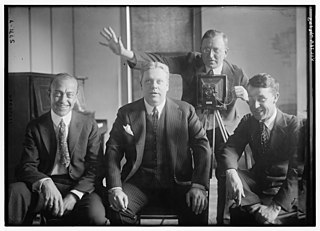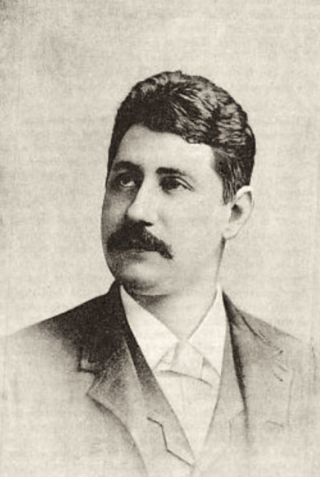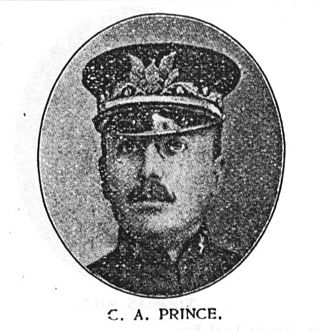
The Haydn Quartet, later known as the Hayden Quartet, was one of the most popular recording close harmony quartets in the early twentieth century. It was originally formed in 1896 as the Edison Quartet to record for Edison Records; it took its new name when recording for other companies. The name was a homage to Joseph Haydn, the classical composer; the spelling was later revised to Hayden, which reflects the way it was pronounced. The group disbanded in 1914.

Thomas Million John Turpin was an American composer of ragtime music. Turpin is credited with the first published rag by an African American, his "Harlem Rag" of 1897.

Arthur Francis Collins was an American baritone who was one of the pioneer recording artists, regarded in his day as "King of the Ragtime Singers".

Byron George Harlan was an American singer from Kansas, a comic minstrel singer and balladeer who often recorded with Arthur Collins. The two together were often billed as "Collins & Harlan".

The Peerless Quartet was an American vocal group that recorded in the early years of the twentieth century. They formed to record for Columbia Records, where they were credited as the Columbia Quartet or Columbia Male Quartet. From about 1907, when they began to record for record labels other than Columbia, they were more widely known as the Peerless Quartet.

Septimus Winner was an American songwriter of the 19th century. He used his own name, and also the pseudonyms Alice Hawthorne, Percy Guyer, Mark Mason, Apsley Street, and Paul Stenton. He was also a teacher, performer, and music publisher.

Ada Jane Jones was an English-American popular singer who made her first recordings in 1893 on Edison cylinders. She is among the earliest female singers to be recorded.

Daniel William Quinn was an American tenor. He was one of the first American singers to become popular in the new medium of recorded music. Quinn was a very successful recording artist whose career spanned from 1892 to 1918. Quinn recorded many of his hits in the legendary Tin Pan Alley of New York City.

Max Spicker was a German American organist, conductor and composer.

Will Oakland was an American countertenor famed for his exceptionally high vocal range. He was born Herman Hinrichs in Jersey City, New Jersey, to German-American immigrant parents.

Charles Adams Prince was an American conductor, bandleader, pianist and organist known for conducting the Columbia Orchestra and, later, Prince's Band and Orchestra. He made his first recordings, as a pianist, in 1891 for the New York Phonograph Company. Later in the 1890s he worked as a musical director for Columbia Records. He also conducted the Columbia Orchestra and Columbia Band starting in 1904 as the successor of the cornetist Tom Clark.

The Congress Mine is a gold mine located at the ghost town of Congress, Arizona, on the southeastern slope of the Date Creek Mountains, approximately 18 miles north-northeast of Wickenburg, Arizona, at an elevation of about 3,000 feet. The nearest community, four miles away, is modern Congress, formerly known as Congress Jct railroad station or Martinez Post Office. The Congress Mine produced substantial quantities of gold and was considered one of the most productive gold mines in Arizona.

Samuel N. Mitchell (1846–1905) was an American song lyricist and newspaperman who wrote lyrics for a number of popular songs in the 1870s.
Silver Threads Among the Gold is a 1915 American silent film starring countertenor Richard Jose. In the film, Jose performs the popular song Silver Threads Among the Gold. The six-reel film was produced by Pierce Kingsley and R. R. Roberts for the K & R film Company.

Harry Lee Tally was an American tenor singer of popular songs, who recorded between 1902 and 1917.

Samuel Holland Rous, who recorded using the name S. H. Dudley, and less frequently as Frank Kernell, was an American singer, pioneer recording artist, and music business executive. He was unrelated to the black vaudeville performer and impresario Sherman Houston Dudley.

Corinne Morgan was the stage name of CorinneWelsh. She was a contralto singer and pioneer recording artist who recorded popular songs in the early years of the twentieth century and was best known for her duets with Frank Stanley. Some sources misspell her name as Corrine.

Joseph Natus was an American minstrel performer and recording artist who was prominent during the early 20th century. He was a tenor.

William A. Penno (1843–1929), known by his stage name William A. Huntley, was a composer, music teacher, and vocal and instrumental performer in minstrel and vaudeville traditions. Playing his 5-string banjo before crowds that came to number in the low thousands, he sang in a high tenor and played his banjo bare fingered, picking the strings in a style today named "classic banjo." His published compositions include banjo instrumentals and parlor music. Huntley spent his working life performing and teaching in the off season. He performed throughout the United States and toured Europe as a part of several different minstrel groups. A highlight of his performing career was to play before the Prince and Princess of Wales, about 1880 at Her Majesty's Theatre in London. He moved away from minstrel shows by the 1880s, and "took pride" that he could perform without blackface stage makeup. He focused on building respectability for the banjo, through teaching, composition, and performance recitals. He was featured in the S. S. Stewart Company's catalog and began to play the company's banjeaurine. In 1888 he performed before a crowd of 2,000 people in his hometown, Providence, Rhode Island.
The following squads were named for the 1929 South American Championship that took place in Argentina.


















